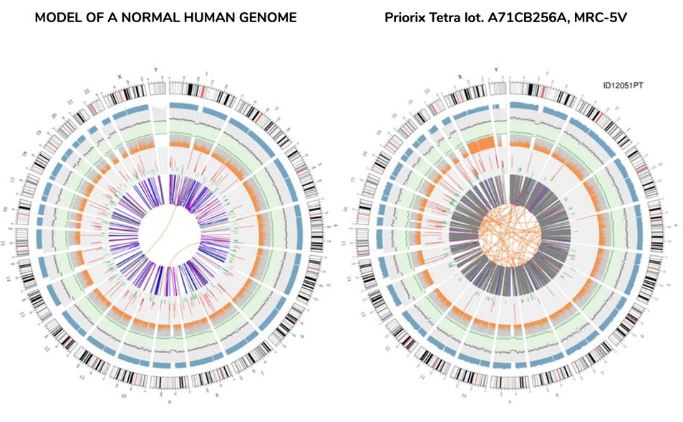
Summary
Some live virus vaccines contain human DNA fragments and even intact DNA. Those vaccines are grown on a medium made from the tissue of aborted human fetuses. Currently they are using old embryonic cell lines from a male fetus (MRC-5) and female fetus (WI=38); the cells are replicated many times in order to provide a continuous supply. Since they are nearing senescence (old age), new cell lines are being developed.
According to renowned vaccinologist, Dr. Stanley Plotkin, who worked on developing the rubella vaccine grown on aborted fetal tissue, coworkers harvested the tissues from aborted fetuses and then cut them up into little pieces which were then cultured; some of the pieces of the fetus used were from the pituitary gland, skin, kidney, spleen, heart, and tongue. 76 aborted fetuses were studied in order to find one whose cells could be used to make the vaccine.
Because living tissue is needed for the primary culture, these abortions are often done by the “water bag” method which delivers the fetuses (between 2-4 months gestation) alive. (Limbs, organs, and tissues from aborted fetuses are also a mainstay of modern medical research.)
Included in vaccines for measles, mumps, rubella, chicken pox, shingles, rotavirus, adenovirus and rabies are human DNA fragments. According to Plotkin, injecting intact DNA is theoretically problematic which is why they fragmented it. Intact human DNA was recently discovered in a vaccine by Corveleva, an independent lab that has been analyzing vaccine contents.
Clinical trials for vaccines look primarily for predefined local and transient adverse events so trial participants are only followed for days or months. Long term effects of vaccines are not part of the clinical trials. Section 13 of each vaccine package insert states that the vaccine has not been studied to determine if the vaccine can cause genetic mutations, cancer, or impaired fertility. They are not required to.
However, scientists have long known that:
- DNA fragmentation is a necessary first step to inserting foreign DNA into cells.
- Through a process called insertional mutagenesis, foreign DNA can be incorporated into a host DNA and cause genetic mutations, cancer, and other health problems.
- Homologous recombination, another type of mutation involving DNA fragments, can cause serious illness.
- Retroviruses found in foreign human DNA can be dangerous when incorporated into the DNA of a human host.
- The embryonic stem cells in which the vaccines are grown are naturally tumorigenic.
The FDA has been studying live virus vaccines because of their potential to cause cancer. Scientists investigating vaccines have been able to identify increases in autism in different countries that coincide with their introduction of live virus vaccines grown in human cell substrates. This is in addition to the previously known problems arising from injecting foreign human DNA into a human host.
While the effect of injecting males with DNA from female fetuses and females with DNA from male fetuses has not been directly studies, a new study does show that autistic individuals are more likely to be transgender and research has investigated the affect of chromosomal abnormalities on areas of the brain related to sexual behavior. This is particularly important in light of the tremendous increase in transgenderism and gender dysphoria (confusion) being reported in many countries as well as in our own frum communities.
Other cell editing technologies carry risks as well.
Rodef Shalom 613 $10,000 Challenge to anyone who can find a molecular biologist willing to sign a letter stating that there is no reason to be concerned about fetal DNA in vaccines. See page 10 for details.
See also: Letter to Community Leaders Worldwide on DNA Mutations